Your browser does not fully support modern features. Please upgrade for a smoother experience.

Submitted Successfully!
Thank you for your contribution! You can also upload a video entry or images related to this topic.
For video creation, please contact our Academic Video Service.
| Version | Summary | Created by | Modification | Content Size | Created at | Operation |
|---|---|---|---|---|---|---|
| 1 | Vladimir Yakushev | -- | 1671 | 2023-06-20 12:26:34 | | | |
| 2 | Jessie Wu | -2 word(s) | 1669 | 2023-06-21 02:51:10 | | |
Video Upload Options
We provide professional Academic Video Service to translate complex research into visually appealing presentations. Would you like to try it?
Cite
If you have any further questions, please contact Encyclopedia Editorial Office.
Yakushev, V. Peculiarities of Permafrost Regions. Encyclopedia. Available online: https://encyclopedia.pub/entry/45856 (accessed on 12 January 2026).
Yakushev V. Peculiarities of Permafrost Regions. Encyclopedia. Available at: https://encyclopedia.pub/entry/45856. Accessed January 12, 2026.
Yakushev, Vladimir. "Peculiarities of Permafrost Regions" Encyclopedia, https://encyclopedia.pub/entry/45856 (accessed January 12, 2026).
Yakushev, V. (2023, June 20). Peculiarities of Permafrost Regions. In Encyclopedia. https://encyclopedia.pub/entry/45856
Yakushev, Vladimir. "Peculiarities of Permafrost Regions." Encyclopedia. Web. 20 June, 2023.
Copy Citation
Russia has unique technical and technological experience of gas field development in permafrost regions. One of the most promising regions of potential large gas field discovery is low-population on-land regions of permafrost spread.
permafrost rocks
cryogenic processes
wellhead site thawing
gas blowouts
gas production well engineering protection
1. Introduction
Humanity needs new natural sources of energy for technological and industrial development. That does not mean the cancellation of old well-known sources such as renewables, biomass, and firewood. They have to occupy their own niche in the world’s energy balance, being oriented on individual and local energy supplies of low power. But according to the main industrial energy source substitution criteria suggested by Jevons [1], firewood and biomass were replaced by coal, coal was replaced by oil and, by logic, oil has now been replaced by natural gas as the main industrial source of energy, providing global competitiveness of the industry. Where do researchers obtain more natural gas? On-land, significant conventional natural gas fields in and around main energy-consumption regions on the Earth have already been explored and are under development or close to exhaustion. The USA has already started wide development of the last on-land natural gas resource—unconventional shale gas, which represents gas naturally generated and still remaining in mother rock (according to the organic theory of oil and gas generation) [2]. Large offshore natural gas fields around main energy-consumption regions are already under development. So, there are two ways of future, new gas developments: smaller fields in populated areas or hope of discovering new large fields in inhabited areas, such as the Arctic. There are many small gas fields in industrially developed areas, but the specific cost of gas production is too high to be competitive with gas produced in remote but large gas fields. So, the discovery and development of new, large natural gas fields are needed to satisfy industry needs.
According to their geological structure, Greenland and a major part of Canada’s permafrost areas are not favorable for natural gas field formation [3][4]. In Canada, gas and gas hydrate fields were discovered on the Arctic shore of the Beaufort Sea and in the Arctic Archipelago of Canada. They are not under development, due to long distances from the fields to main gas-consuming centers. In Alaska, there are the large oil fields of Prudhoe Bay and Kuparuk River, having been operated under permafrost conditions for a long time. But there are no gas and gas condensate fields under development. Moreover, permafrost conditions at the North Slope of Alaska are soft: from the surface, permafrost rocks are represented by large-grained sands and gravel, which have no considerable deformation when thawed [5][6].
The only country that has produced natural gas through the permafrost rock zone with different geocryological conditions for many decades is Russia. Since the first discovery of large gas fields in the middle of the 1960s in the north-east part of Europe, in West and East Siberia, the question of natural gas well operation in the permafrost zone became critical [7]. Having no experience of well drilling, during completion and operation in the permafrost zone and using technologies developed for warmer geologic sections, drillers and operators from the beginning of development have encountered such unexpected problems as drill mud and grouting mortar circulation loss, well column deformation in the expected operation time period (back freezing), and well-side subsidence after beginning operation [7][8][9][10]. But the most dangerous were unexpected gas blowouts from shallow permafrost when drilling, destabilization of the well-head after beginning operation, and intracasing and behind-the-casing gas leaks. A study of gas composition from these liberations and blowouts showed that this gas was generated in permafrost presumably by microbes decomposing buried organic matter [11][12][13][14][15][16].
2. Permafrost Regions
Permafrost occupies about 70% of Russia. Few large oil- and gas-bearing provinces have been discovered in the permafrost area. The most intensive development of gas fields is currently in the north of West Siberia, where the most severe problems have been encountered. They are caused by the following factors: permafrost temperature, permafrost rock thickness, cryolithozone thickness (depth of 0 °C isotherm), rock ice content (vol.), presence of ice bodies in the permafrost section, rock mineral composition, rock salinity and unfrozen water content, presence of cryopegs, and presence of shallow gas and gas hydrate accumulations [17][18][19][20].
It was revealed that permafrost conditions can be very different even at nearby fields. In the north of West Siberia, permafrost rock intervals can be encountered at different depths in one location. This is attributed to the presence of ancient (relic) permafrost rock depth intervals at the south border of current spreading permafrost (Figure 1).
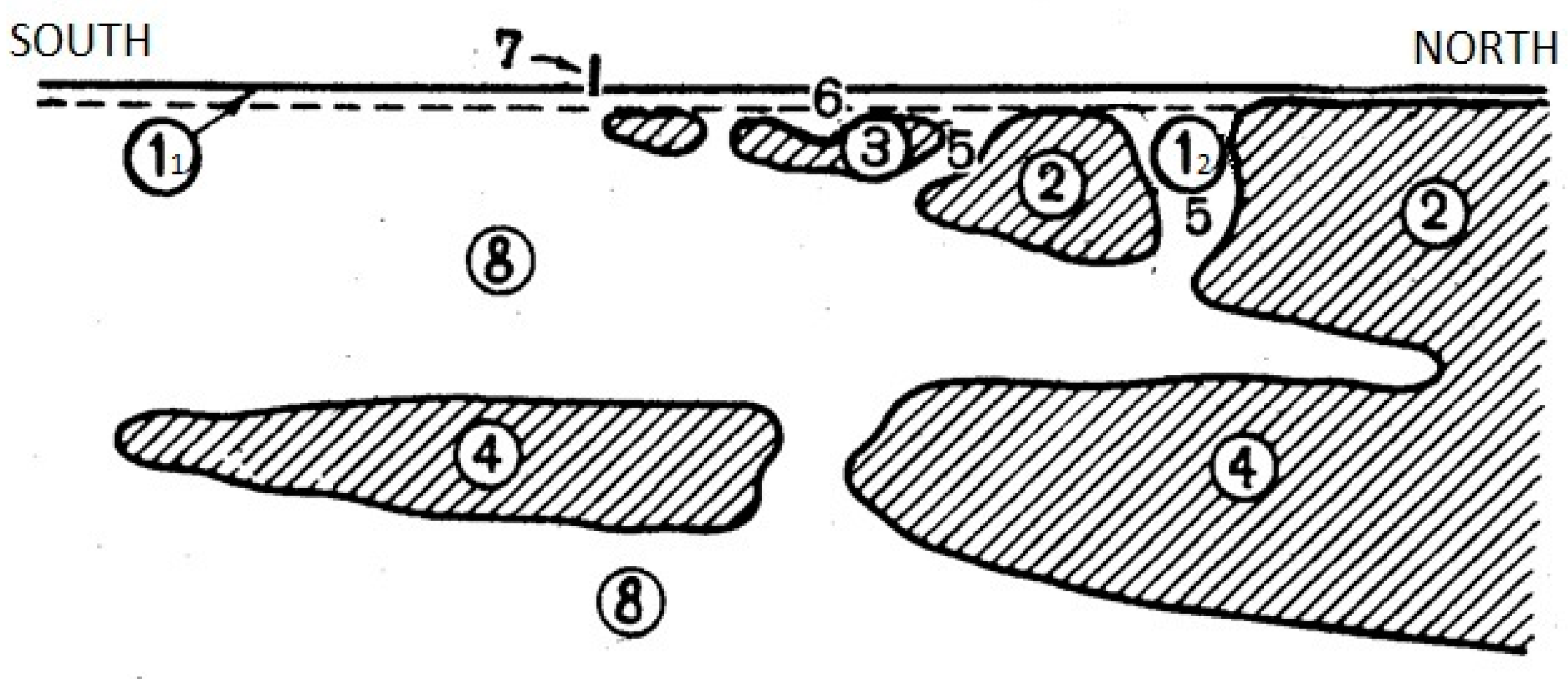
Figure 1. Scheme of permafrost geological section in the North of West Siberia [17]. 11—Seasonal freezing layer; 12—seasonal thawing layer; 2—current continuous permafrost; 3—current discontinuous permafrost; 4—ancient (relic) continuous and discontinuous permafrost; 5—open taliks; 6—closed taliks; 7—current south border of permafrost spreading; 8—unfrozen rocks.
It is also important to determine at what stage of permafrost layer development the gas production region is currently: aggradation or degradation. This could be obtained through geothermal gradient measurement in observation wells (Figure 2). When the freezing front moves down, the temperature gradient below it is considerable due to quick (in geologic timescale) chilling of the geological section. Chilling flow from the Earth’s surface is stronger than natural heat flow from Earth entrails. At the same time, the freezing of pore water at the front level causes additional heat generation, so researchers can see a heat “wave” (Figure 2A). But when permafrost thaws from below and the natural heat flow is stronger than the chilling flow, ice-containing rocks at the permafrost bottom require large heat energy for thawing due to the heat of the water phase transition. This heat consumption at the permafrost low border holds the temperature in rocks close to 0 °C for a considerable depth interval (Figure 2B).
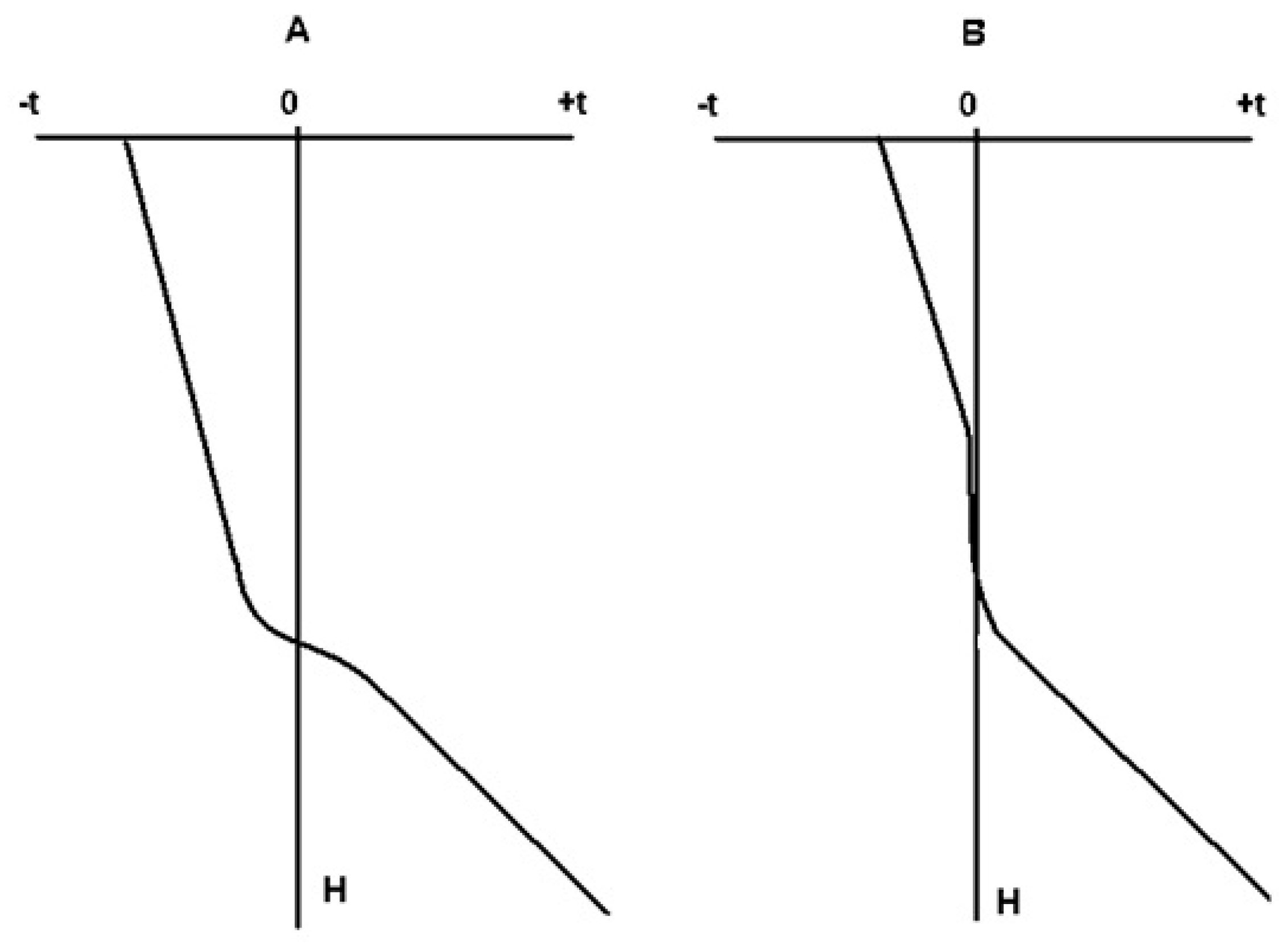
Figure 2. Temperature distribution with depth with permafrost aggradation (A) and degradation (B). H—depth, t—temperature (°C) [21].
The stage of permafrost development is needed for prediction of the natural temperature change of the surrounding rock massif when the production well is under long-time operation and the thawed radius is predicted.
The ice content of permafrost rocks and its distribution with depth are some of the most important parameters of permafrost. Ice can be disseminated in the pore space and be invisible, it can be represented by small visible inclusions in dispersed rocks (cryostructures, Figure 3), or it can form buried large ice bodies in geological sections [22][23][24].
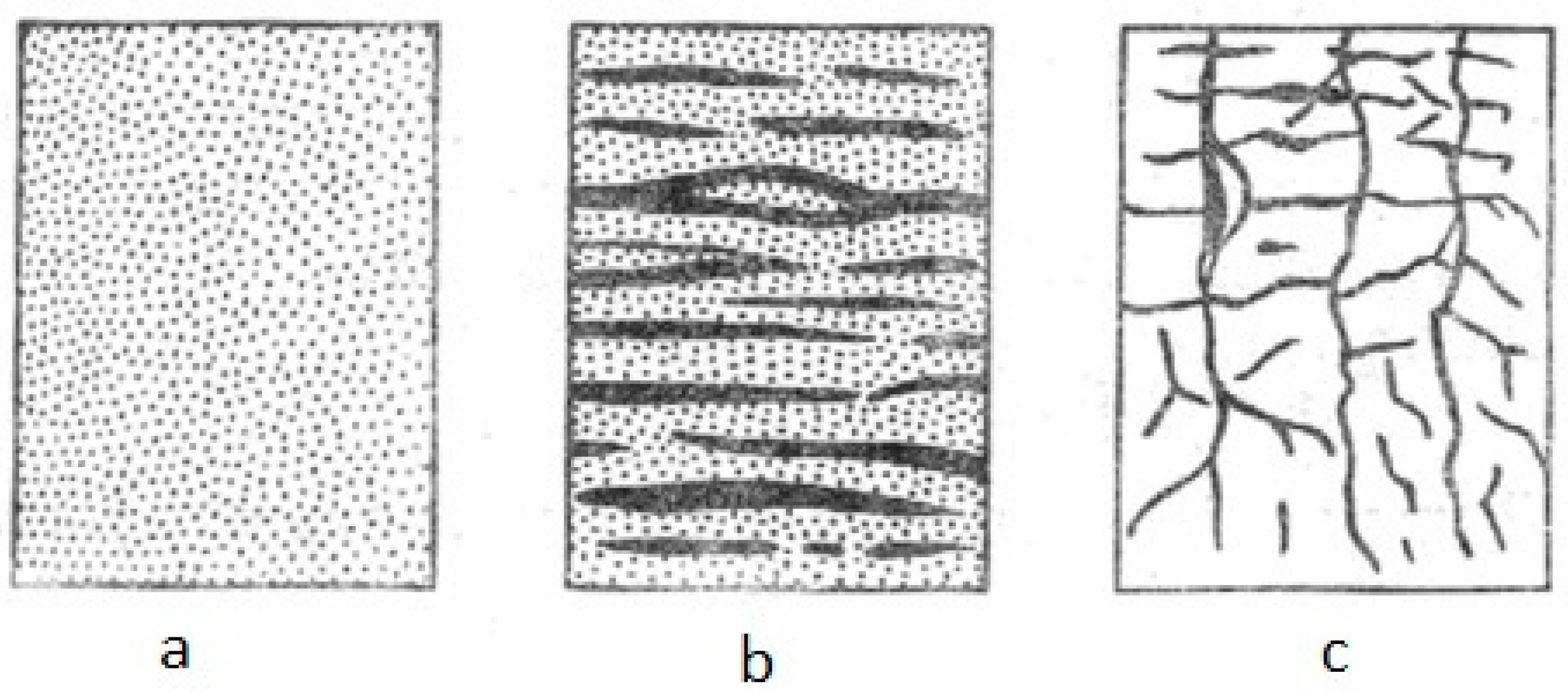
Figure 3. Cryostructure types in frozen rocks (according to Tsytovich, 1974 [22]). (a) Continuous (massive), (b) layered (lens-like), (c) cell-like.
The greatest pore ice content is usually in the upper subsurface rocks and decreases down the geological section. The largest ice content is documented in clays and loams (pore ice content more than 90%, rock volume ice content of 20–80%) [21].
Large ice bodies in geological sections can be represented by buried ice layers remaining after ancient areal deglaciation, by pingo ice (ice core of pingoes), or by developing wedge ice (Figure 4).
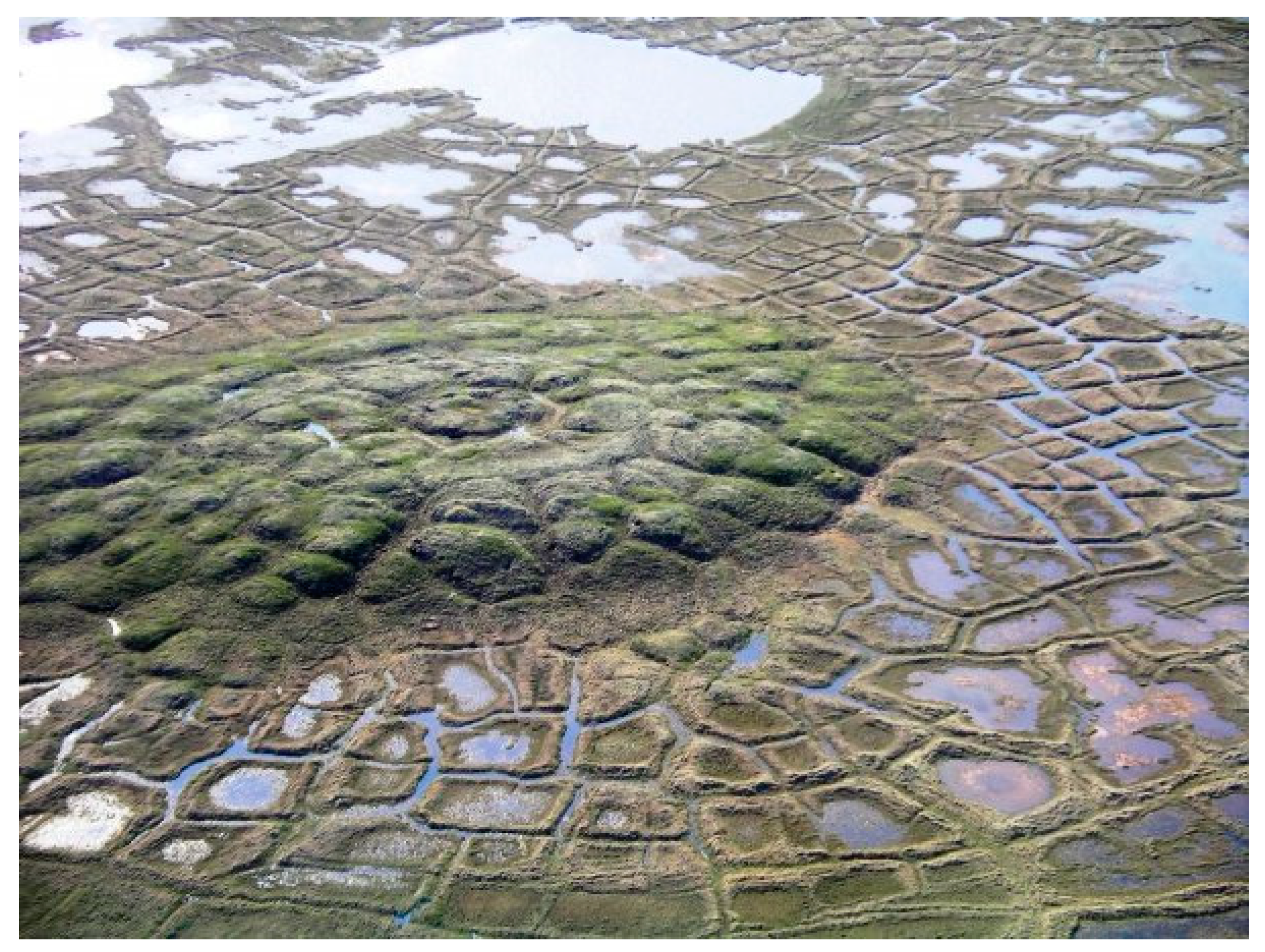
Figure 4. Polygonal-wedge ice network around pingo hill with thermokarst processes development. Rock polygons were formed by frost cracking of ice-saturated surface rocks. Cracks between polygons were filled by water in the summertime. In the wintertime, the water froze [21].
The great ice content in subsurface-dispersed rocks leads to the development of quick thermokarst (surface subsidence caused by ice thawing) and thermoerosion (ravine formation caused by warm water flow) processes if any temperature changes on the permafrost surface (Figure 5). Temperature changes are often caused by human-made damage to the plant (in summer) and snow (in winter) layers. Such damage affects the metastable heat exchange regime between the atmosphere and soil, increasing or decreasing the depth of the seasonal thawing/freezing layer. The change in this layer thickness causes a change in seasonal surficial water drainage intensity, especially in tundra areas, and this is the main reason of the fast development of surface geocryological processes. These processes can change the landscape of considerable area in 1–2 years.
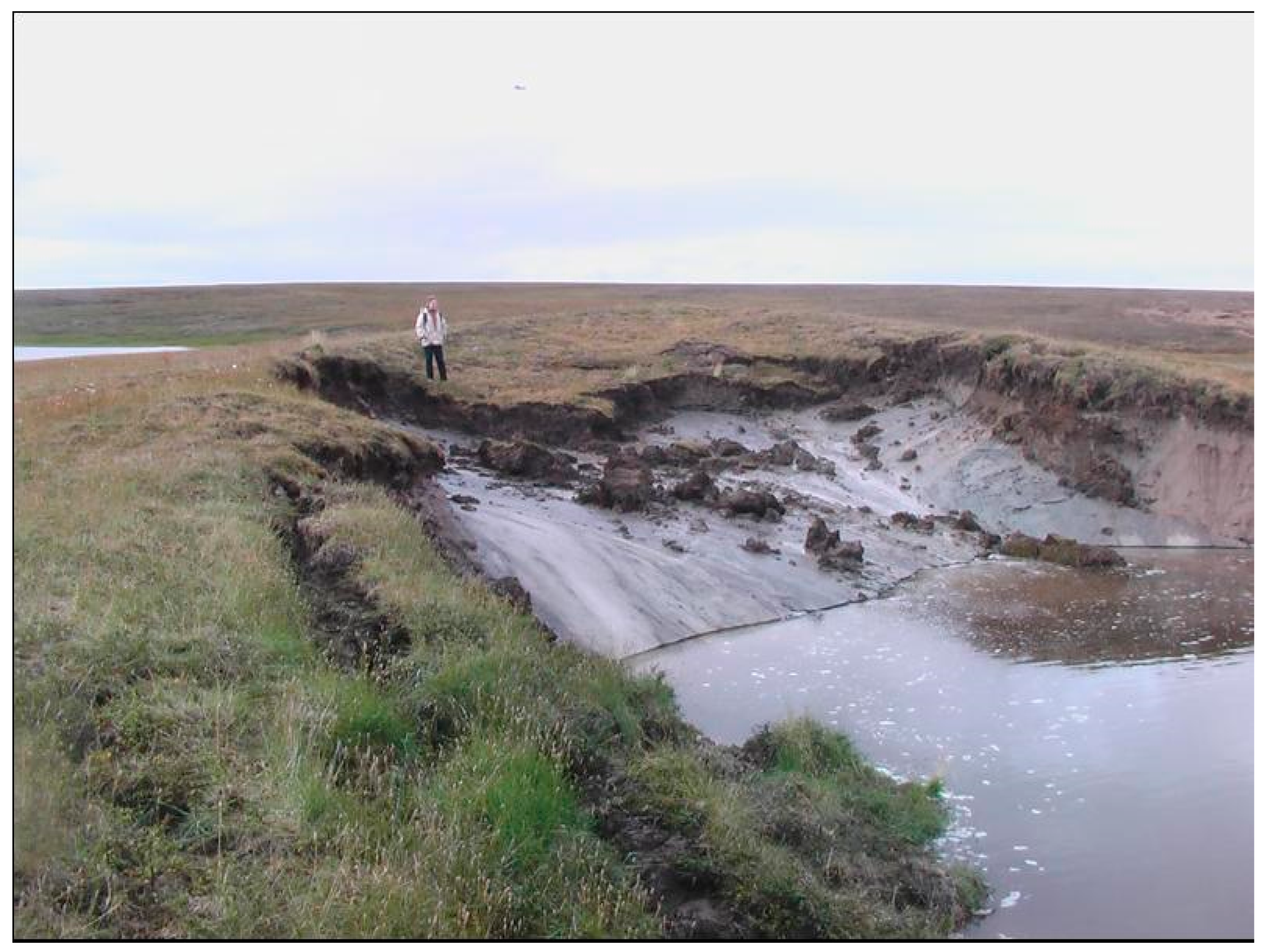
Figure 5. Buried ice body thawing (thermokarst) at Yamal peninsula (North of West Siberia, photo by A. B. Osokin). Technogenic impact caused tundra surface thawing and the occurrence of a partially naked ice body that started to thaw more faster than the surrounding ground, forming a thermokarst lake.
Special attention has to be addressed to intrapermafrost natural gas and gas hydrate accumulations during the drilling and operation of wells. Permafrost is not impermeable to natural gas [25]. Gas inside the permafrost has different geneses. It can be local or microbial. It can be thermogenic, originate from greater depths, and sometimes originate from productive horizons. It can be generated in coal or gas shale deposits and it can finally be represented by air buried during surface geologic processes [26]. The dominant gas inside permafrost is methane, but some other light hydrocarbon gases as well as nitrogen and carbon dioxide are often represented in small volumes. Permafrost is not a geologically stable phenomenon: it changes with time, and pressure/temperature changes inside permafrost sections can result in hydrate formation and preservation, so permafrost can be saturated by relic gas hydrates from the first meters of depth [27]. Moreover, all-side rock massif freezing in pingo formation can result in sudden water–gas blowouts with the formation of considerable craters on the day surface (Figure 6).
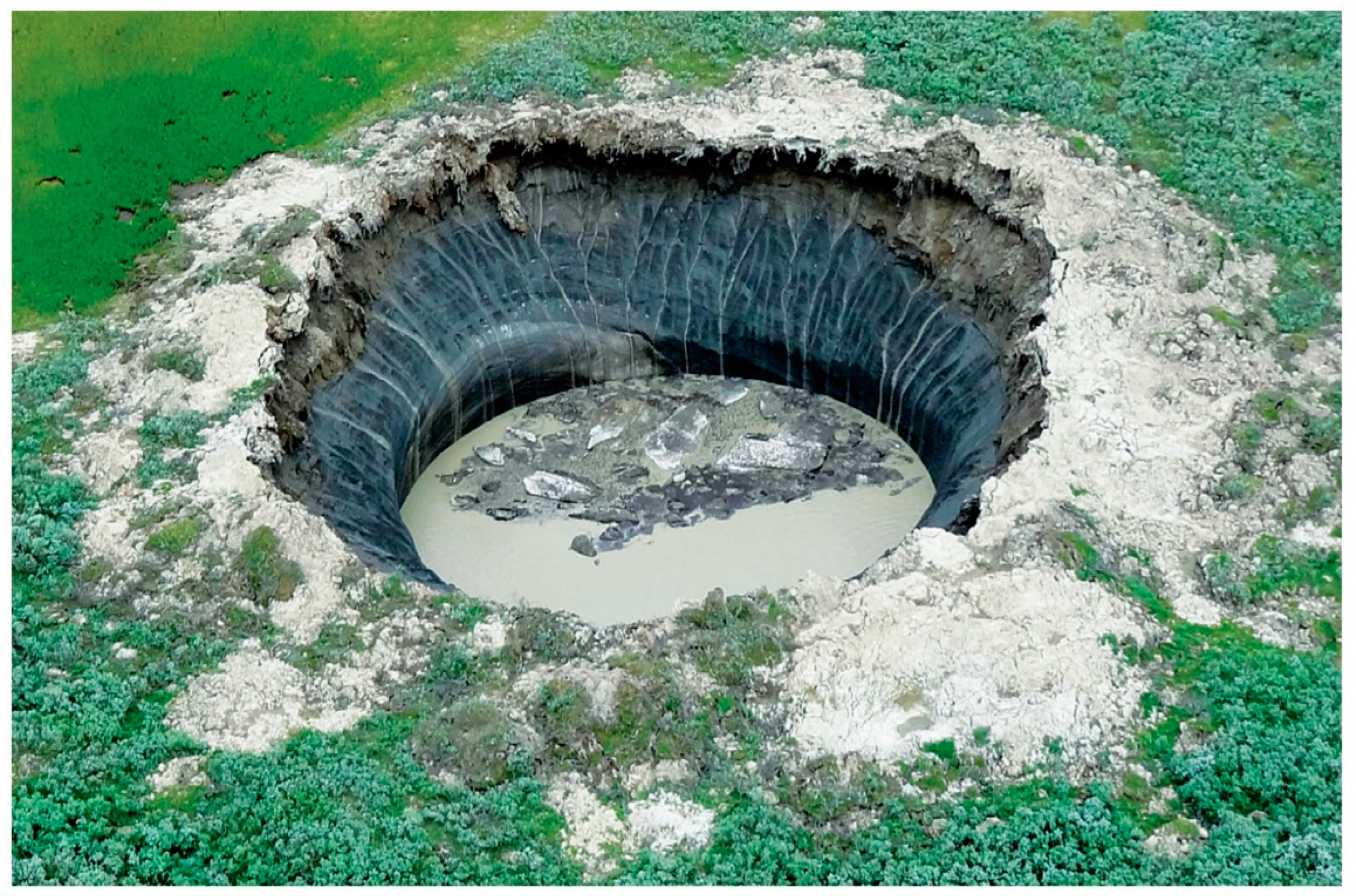
Figure 6. “Ice crater” with diameter of about 30 m in Yamal peninsula tundra (Photo by Bogoyavlensky [28]).
Favorable conditions for hydrate formation appear at the lower border of thick permafrost (permafrost thickness more than 270 m for methane hydrate) (Figure 7). So, stable hydrates can be encountered at lower parts of the permafrost as well as below its lower border.
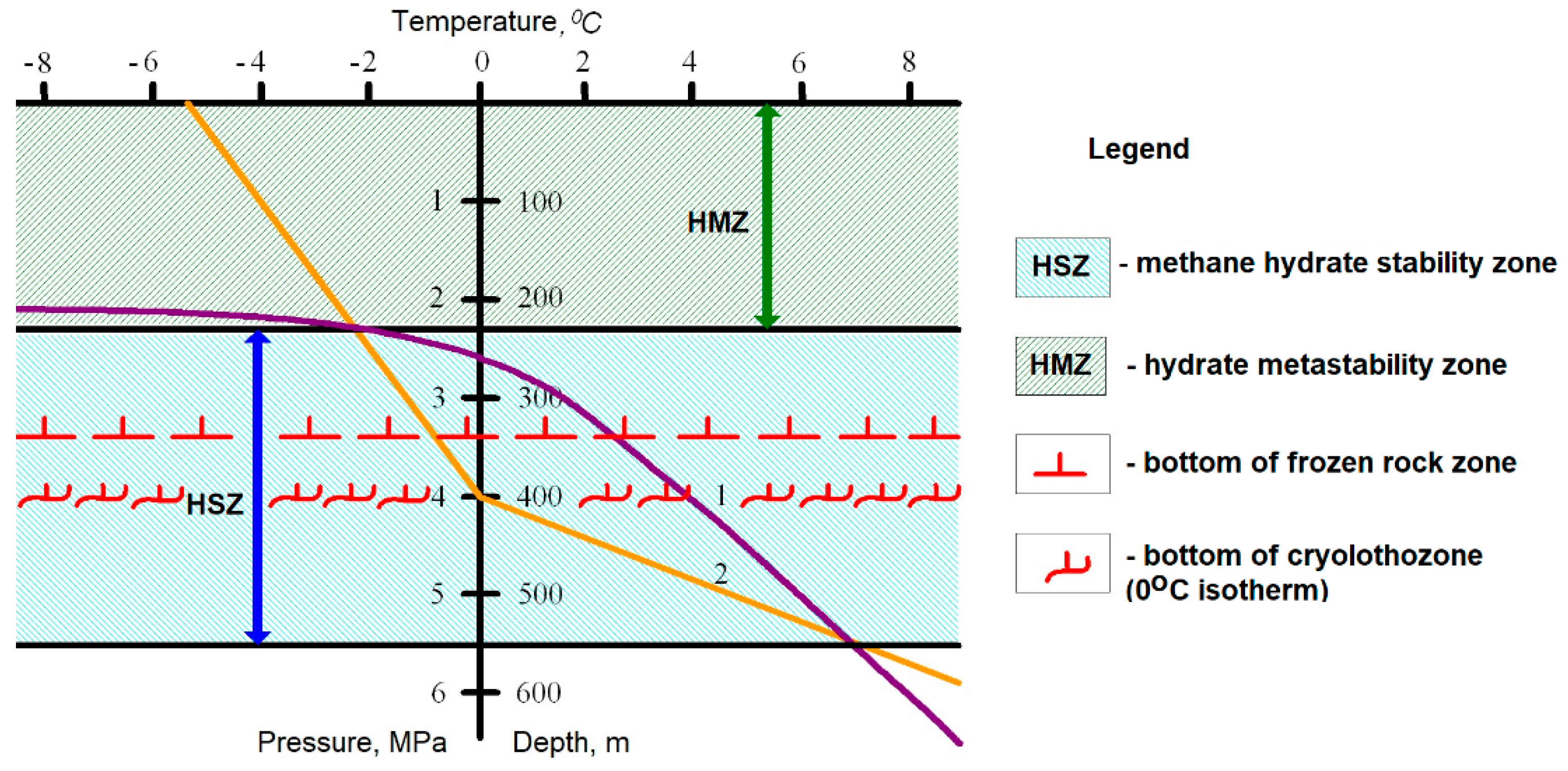
Figure 7. Methane hydrate stability zone and hydrate metastability zone in geological section with permafrost (inside cryolithozone) [25]. 1—Methane hydrate formation equilibrium curve; 2—Natural temperature/pressure distribution in geologic section.
Thus, permafrost regions have considerable differences to unfrozen ones. Permafrost is not a stable natural system: it constantly changes under natural and human-made impact. It has a complex structure and is often very reactive due to special properties of frozen rocks based on the presence of ice, gas, and gas hydrate in permafrost sections.
References
- Jevons, W.S. The Coal Question: An Inquiry Concerning the Progress of the Nation, and the Probable Exhaustion of Our Coal-Mines, 3rd ed.; Flux, A.W., Ed.; Macmillan: London, UK, 1906.
- Okeke, O.C.; Okogbue, C.O. Shales: A review of their classifications, properties and importance to the petroleum industry. Glob. J. Geol. Sci. 2011, 9, 55–73.
- Henriksen, N.; Higgins, A.K.; Kalsbeek, F.; Christopher, T.; Pulvertaft, R. Greenland from archaean to quaternary descriptive text to the 1995 geological map of Greenland, 1:2,500,000. 2nd edition. Geol. Surv. Den. Greenl. Bull. 2009, 18, 2–93.
- Hoffman, P.F. Precambrian geology and tectonic history of North America. In The Geology of North America—An Overview; Bally, A.W., Palmer, A.R., Eds.; Geological Society of America: Boulder, CO, USA, 1989; pp. 447–511.
- Osadetz, K.; Dixon, J.; Dietrich, J.; Snowdon, L.; Dallimore, S.; Majorowicz, J. A review of Mackenzie Delta-Beaufort Sea petroleum province conventional and nonconventional (gas hydrate) petroleum reserves and undiscovered resources: A contribution to the resource assessment of the proposed Mackenzie Delta-Beaufort Sea Marine Protected Areas. Geol. Surv. Canad. Open File 2005, 4828, 31.
- Raynolds, M.K.; Walker, D.A.; Ambrosius, K.J.; Brown, J.; Everett, K.R.; Kanevskiy, M.; Kofinas, G.P.; Romanovsky, V.E.; Shur, Y.; Webber, P.J. Cumulative geoecological effects of 62 years of infrastructure and climate change in ice-rich permafrost landscapes, Prudhoe Bay Oilfield, Alaska. Glob. Chang. Biol. 2014, 20, 1211–1224.
- Biskaborn, B.K.; Smith, S.L.; Noetzli, J.; Matthes, H.; Vieira, G.; Streletskiy, D.A.; Schoeneich, P.; Romanovsky, V.E.; Lewkowicz, A.G.; Abramov, A.; et al. Permafrost is warming at a global scale. Nat. Commun. 2019, 10, 264.
- Andreev, O.F.; Kolushev, N.R. Problems of wells and production facilities operation realiabiliry providing in cryolithozone. In Peculiarities of Gas Fields Development in Complex Geocryoloigic Conditions; Andreev, O.F., Kolushev, N.R., Eds.; Gazprom VNIIGAZ: Moscow, Russia, 1987; pp. 4–7. (In Russian)
- Byunau, Y.K.; Borisov, V.B.; Ploskov, A.A.; Zakharov, M.I. Methodical and Instrumental Measurement Providing of Thermophysical Charackterisics of Heat-Isolated Lift and Tubing Strings; Gazprom VNIIGAZ: Moscow, Russia, 2012; p. 48. (In Russian)
- Vrachyev, V.V.; Antipov, V.I.; Podolyako, M.I. Calculation of radial loading on casing at Urengoy gas field conditions. In Peculiarities of Gas Fields Development in Complex Geocryoloigic Conditions; Andreev, O.F., Kolushev, N.R., Eds.; Gazprom VNIIGAZ: Moscow, Russia, 1987; pp. 68–79. (In Russian)
- Bogoyavlensky, V.I. Natural and technogenic threats in fossil fuels production in the Earth cryolithosphere. Russ. Min. Ind. 2020, 97–118. (In Russian)
- Yakushev, V.S. One of possible reasons of sudden gas blowouts in permafrost rock massifs. Geol. Oil Gas 1989, 4, 45–46. (In Russian)
- Bogoyavlensky, V.I.; Bogoyavlensky, I.V.; Nikonov, R.; Kishankov, A. Complex of Geophysical Studies of the Seyakha Catastrophic Gas Blowout Crater on the Yamal Peninsula, Russian Arctic. Geosciences 2020, 10, 215.
- Chuvilin, E.; Sokolova, N.; Davletshina, D.; Bukhanov, B.; Stanilovskaya, J.; Badetz, C.; Spasennykh, M. Conceptual models of gas accumulation in the shallow permafrost of Northern West Siberia and conditions for explosive gas emissions. Geosciences 2020, 10, 195.
- Kraev, G.; Rivkina, E.; Vishnivetskaya, T.; Belonosov, A.; van Huissteden, J.; Kholodov, A.; Smirnov, A.; Kudryavtsev, A.; Teshebaeva, K.; Zamolodchikov, D. Methane in Gas Shows from Boreholes in Epigenetic Permafrost of Siberian Arctic. Geosciences 2019, 9, 67.
- Yakushev, V.S. Natural Gas Liberations around Production Wells at Russian Arctic Gas Fields. Geosciences 2020, 10, 184.
- Kudryavtsev, V.A. General Permafrostology (Geocryology), 2nd ed.; Moscow State University: Moscow, Russia, 1978; p. 464. (In Russian)
- Ershov, E.D. General geocryology. In Manual for High School; Cambridge University Press: Cambridge, UK, 2002; p. 682.
- Dobrinski, W. Permafrost. Earth-Sci. Rev. 2011, 108, 158–169.
- STO Gazprom 2-3.1-233-2008; The Technique of Geocryologic Survey Conduction When Gas Fields Exploration and Development. IRC Gazprom: Moscow, Russia, 2008; p. 115. (In Russian)
- Yakushev, V.S. Gas and Gas Condensate Fields Development at Complicated Geocryological Conditions; Gubkin University: Moscow, Russia, 2014; p. 188. (In Russian)
- Tsytovich, N.A. Mechanics of Frozen Rocks, 2nd ed.; LIBROCOM Public: Moscow, Russia, 2010; p. 448, Reprinting of textbook 1974. (In Russian)
- Penner, E. Aspects of ice lens growth in soils. Cold Reg. Sci. Technol. 1986, 13, 91–100.
- Ershov, E.D.; Lebedenko, Y.P.; Chuvilin, E.M.; Yazynin, O.M. Microstructure of Frozen Rocks; Moscow State University: Moscow, Russia, 1988; p. 183. (In Russian)
- Yakushev, V. Natural Gas and Gas Hydrates in Cryolithozone; Gazprom VNIIGAZ: Moscow, Russia, 2009; p. 192. (In Russian)
- Yakushev, V. Genetic types of hydrocarbon gases in permafrost. Earth’s Cryosphere 2015, 3, 71–76. (In Russian)
- Yakushev, V.S.; Chuvilin, E.M. Natural gas and gas hydrate accumulations within permafrost in Russia. Cold Reg. Sci. Technol. 2000, 31, 189–197.
- Bogoyavlensky, V.; Mazharov, A.; Pushkarev, V.; Bogoyavlensky, I. Gas emissions from the Yamal peninsula permafrost areas. Preliminary results of the expedition dated 8th July 2015. Drill. Oil 2015, N 07-08, 8–13. (In Russian)
More
Information
Subjects:
Green & Sustainable Science & Technology
Contributor
MDPI registered users' name will be linked to their SciProfiles pages. To register with us, please refer to https://encyclopedia.pub/register
:
View Times:
806
Revisions:
2 times
(View History)
Update Date:
21 Jun 2023
Notice
You are not a member of the advisory board for this topic. If you want to update advisory board member profile, please contact office@encyclopedia.pub.
OK
Confirm
Only members of the Encyclopedia advisory board for this topic are allowed to note entries. Would you like to become an advisory board member of the Encyclopedia?
Yes
No
${ textCharacter }/${ maxCharacter }
Submit
Cancel
Back
Comments
${ item }
|
More
No more~
There is no comment~
${ textCharacter }/${ maxCharacter }
Submit
Cancel
${ selectedItem.replyTextCharacter }/${ selectedItem.replyMaxCharacter }
Submit
Cancel
Confirm
Are you sure to Delete?
Yes
No




